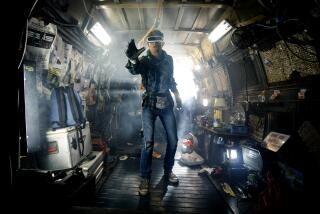E3 2019: Will Microsoft’s ‘Minecraft Earth’ take augmented reality beyond ‘Pokémon Go’?
One began as a passion project and turned into a svelte, goofy and surprisingly slick little action game. Another started as a tech experiment and now has ambitions on conquering the world, one neighborhood at a time.
Both represent Microsoft’s vision for the second decade of “Minecraft,” whose studio the company purchased in 2014. Microsoft came to the Electronic Entertainment Expo (E3) to tout its streaming initiatives, tease a new “Halo” game and lay the groundwork for a new home console to be released in 2020.
More immediately making an impression, however, are the two new “Minecraft” titles designed to take the family-friendly, creation-based game in different directions. All eyes will be on “Minecraft Earth,” an augmented reality game coming to Android and iOS devices, which will begin beta testing in the coming weeks. Microsoft hopes the title will show that there’s far more to the experimental gaming space than “Pokémon Go.”
But don’t overlook “Minecraft Dungeons,” due out for most major platforms in spring 2020 and designed by a relatively compact team (for a major studio at least) of 20.
The action-adventure fantasy game will combine familiar sword and sorcery gameplay with a touch of humor — for instance, the keys you need to open doors may bounce away from you from time to time. It’s a fast-paced, randomized and cooperation-based game that infuses the blocky-looking franchise with cartoon zaniness.
E3 2019: Why you’ll love Nintendo’s gooey Gooigi in ‘Luigi’s Mansion 3’ »
Microsoft is estimated to have spent $2.5 billion in 2014 for control of “Minecraft’s” Stockholm studio Mojang. At the time, “Minecraft” was among the top-five selling games of the year. More recent reports from the Electronic Software Assn., the trade body that hosts E3, place “Minecraft” at No. 11, but over its 10-year lifespan the work has sold more than 176 million copies, leading some to speculate it may be the bestselling game of all time.
And in 2019, Microsoft is taking more aggressive steps to expand the “Minecraft” brand. “One of the models I look at is Lego, when I think about ‘Minecraft,’” says Microsoft’s Xbox chief Phil Spencer of the company’s ambitions.
There’s no denying there’s a tinge of a Lego influence in “Minecraft Earth,” as the AR game will allow players to show their budding architect skills and then place their creations out in the real world.
But the location-based title is also designed to encourage exploration. Sure, there will be opportunities to go on “Minecraft” adventures and virtually battle skeletons and other creatures out in physical spaces, but if users gravitate to the game it should be one that encourages creativity by allowing players to integrate their own designs with very-real infrastructure.
Now about three years removed from the release of “Pokémon Go,” “Minecraft Earth” will also be an opportunity to gauge the long-term viability of AR as a form of play. So far, few experiences have captured the public’s imagination as much as “Pokémon Go.”
In addition to “Minecraft Earth,” this year should also see the release of “Harry Potter: Wizards Unite,” the latest from “Pokémon Go” publisher Niantic.
If there’s any commonality among the three, it’s that they use screens to get players moving.
“It harkens back to the way that physical play used to be,” says “Minecraft Earth’s” art director Brad Shuber, noting that the game’s AR mode cannot be turned off. It’s designed from the ground-up to see our current environment in a new light.
The game was born out of the company’s early experiments with its so-called HoloLens technology, a glasses-like headset that could superimpose holographic-like images in a limited field of view. Smartphone-driven augmented reality became a way to turn what was once just a test into something that could be fit for the masses.
Booting up the game will bring up a “Minecraft” map of one’s surroundings, one that when the game launches should be full of tappable items that one can use to build and fill structures with digital creatures. When playing with others and taking out some skeletons with digital arrows, all the found resources will be shared to encourage collaboration and discourage selfish behavior.
E3 2019: Is the video game industry ready for pop-culture saturation? »
Likewise, if one spends days or weeks perfecting a “Minecraft” structure to, say, live next to Disney Hall, which itself has experimented with augmented reality, “Minecraft Earth” will have modes that allow for others to see it — and play with it or even ruin it. What they’ll often be working with is essentially just a duplicate of the original. Your creation, in other words, will still stand.
“Eventually there will be places where you can put your build so that people can come find it and view it,” says Shuber. “And if they do muck with it, it doesn’t affect the thing you left behind because it’s just a copy. So people can enjoy it — they can destroy it, they can have fun, they can figure out how you did it, but the thing that you made stays intact.”
If all goes according to plan, then “Minecraft Earth” will give this digital universe a bit more permanence in ours.
More to Read
The biggest entertainment stories
Get our big stories about Hollywood, film, television, music, arts, culture and more right in your inbox as soon as they publish.
You may occasionally receive promotional content from the Los Angeles Times.











